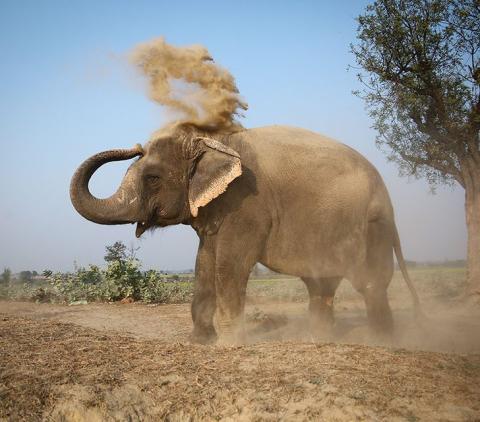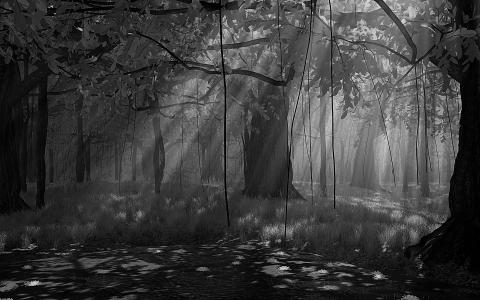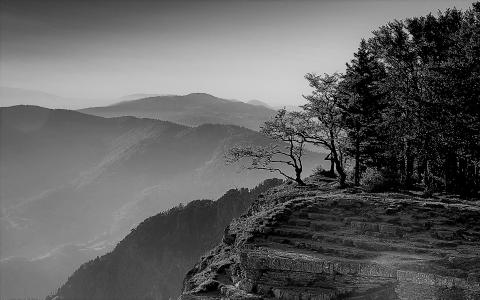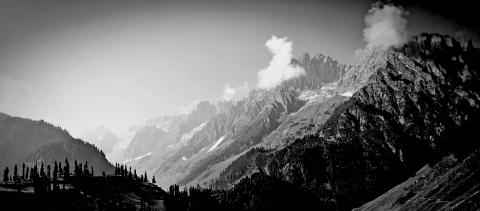February 2023

A few days later, he summoned a few brāhmaṇas and said ‘I had a dream in the early hours this morning. In it, I was out for my routine horse ride, when a wild elephant appeared out of nowhere. My royal elephant sensed the odour of the wild beast’s rut, and got incensed. Tearing off its binding post, it rushed forward and confronted it. The wild elephant reared its trunk and trumpeted disdainfully. My elephant fell upon it and drove its tusks...

60. Kulyāpraṇayana-nyāya
Kulyā means a channel. People dig up channels so that the water can be transferred to the fields to irrigate the crops. The main purpose is agriculture. But the water can be used for drinking, for washing clothes, for bathing. While the primary purpose is different, the same can be used to serve many other purposes. This nyāya is used to illustrate such things.
61. Kūpakhānaka-nyāya
The labourer whose work is to dig...

Arjuna’s mind is gaining maturity. Didn’t Bhagavān say –
dadāmi buddhi-yogam...
BG 10.10
What is buddhi-yoga? Buddhi is a faculty of the antaḥkaraṇa. Manas (mind), saṅkalpa (will), jñāpaka (recall) and other mental faculties hanker after so many external objects, collecting sensory information about them. The buddhi (intellect) gathers all these pieces of information under its purview, analyses them, classifies them, assesses their...

ಪರಿಷ್ಕೃತ ಲಕ್ಷಣ
ಈ ಎಚ್ಚರಿಕೆಗಳ ಹಿನ್ನೆಲೆಯಲ್ಲಿ ಪರಿಶೀಲಿಸಿದಾಗ ಈ ಮುನ್ನ ಹೇಳಿದ ಶ್ಲೋಕದ ಲಕ್ಷಣಗಳು ಪರ್ಯಾಪ್ತವಲ್ಲವೆಂದು ತಿಳಿಯುತ್ತದೆ. ಬಹುಶಃ ಈ ಕಾರಣದಿಂದಲೇ ಮಧ್ಯಕಾಲೀನ ಛಂದೋವಿದರು ಇನ್ನಷ್ಟು ಪರಿಷ್ಕೃತವಾದ ಲಕ್ಷಣವನ್ನು ರೂಪಿಸಿದ್ದಾರೆ. ಉದಾಹರಣೆಗೆ ‘ವೃತ್ತರತ್ನಾಕರ’ದ ನಾರಾಯಣಭಟ್ಟೀಯ ವ್ಯಾಖ್ಯೆಯು ಶ್ಲೋಕದ ಎಲ್ಲ ಪಾದಗಳ ಮೊದಲ ನಾಲ್ಕು ಅಕ್ಷರಗಳ ವಿನ್ಯಾಸಗಳಿಗೂ ಅನ್ವಯಿಸುವಂಥ ಕೆಲವೊಂದು ನಿಯಮಗಳನ್ನು ರೂಪಿಸಿದೆ (೨.೨೧). ಅವು ಹೀಗಿವೆ:
ಪ್ರತಿಯೊಂದು ಸಾಲಿನ ಮೊದಲ ಹಾಗೂ ಕೊನೆಯ ಅಕ್ಷರಗಳ ಗುರುತ್ವ ಅಥವಾ ಲಘುತ್ವಗಳಲ್ಲಿ ಐಚ್ಛಿಕತೆ ಉಂಟು. ಆದರ...

Upa-rūpakas (Continued)
10. Rāsa – Like goṣṭhi and hallīsaka, rāsa is a kind of Śrī-kṛṣṇā-līlā-nṛtya – a form of dance associated with the divine exuberance of Śrī-kṛṣṇa. Rāsa is also a kind of maṇḍala-nṛtya – group dance; Śrī-kṛṣṇa dances amidst a group of eight, twelve, or sixteen gopikās; rāsa is also a kind of tāla and this form of dance naturally comes with many different tāla-patterns. Dance is performed both at slow and fast tempos;...

Then he thought, ‘Fie upon me – I brought this allegation upon myself! Or why should I blame myself? The king was happy for a long time. Which other prince achieved so much, uprooted both the internal and external enemies with great tact? Did any of them take great care such that the varṇāśrama-dharma was followed without lapses? Who else has a son like Avantivardhana who is blessed with such noble qualities? Let all these be so; hasn’t...

Upa-rūpakas (Continued)
3. Prasthāna – the emotional states of apsaraḥ-strī or a proṣitapatikā are presented in a prasthāna. The story captures the pangs of separation of a nāyikā, whose beloved is out on a journey (prasthāna). It also narrates the manner in which the nāyikā and the nāyaka finally unite, traversing the vīra and adbhuta rasas. Aestheticians such as Bhoja, Rāmacandra-Guṇacandra, and Abhinava-gupta say that different seasons...

Note
nija-mahimeyan-īśaṃ tā-
n-ajan-avyayan-aprameya-navaviliptaṃ meṇ ।
tri-jagad-vyāptaṃ śaktaṃ
bhajanīyaṃ kāmyaneṃbudaṃ baṇṇisuvam ॥
Īśvara, the birthless, imperishable,
immeasurable, unattached,
pervader of all the three worlds, and powerful,
describes his own glory and
shows how he can be praised and loved.
Summary
Our freedom to discern must be used to gain the knowledge of Bhagavān’s nature, his non-attachment and omnipotence....

೨. ವಿಷಮಪಾದದ ಉತ್ತರಾರ್ಧದಲ್ಲಿ ಲಘುಬಾಹುಳ್ಯವುಳ್ಳ ಸಂದರ್ಭಗಳಲ್ಲಿ ಆಯಾ ಓಜಪಾದಗಳ ಪಂಚಮಾಕ್ಷರಗಳು ಲಘು ಅಥವಾ ಗುರುವೇ ಆಗಿರಲಿ, ಮೇಲಣ ಎಚ್ಚರಿಕೆಯನ್ನು ಪಾಲಿಸಿದ್ದೇ ಆದಲ್ಲಿ ಶ್ಲೋಕದ ಧಾಟಿ ಕೆಡುವುದಿಲ್ಲ. ಇಂತಿದ್ದರೂ ಪಂಚಮಾಕ್ಷರವು ‘ಲಕ್ಷಣವಿರುದ್ಧ’ವಾಗಿ ಗುರುವಾದಲ್ಲಿ ಒಟ್ಟಂದದ ಶ್ಲೋಕಗತಿಗೆ ಹೆಚ್ಚಿನ ಸೊಗಸು ಬರುತ್ತದೆ. ಉದಾ:
ಷಾಣ್ಮಾತುರಃ ಶಕ್ತಿಧರಃ ಕುಮಾರಃ ಕ್ರೌಂಚದಾರಣಃ || (ಅಮರಕೋಶ, ೧.೧.೪೭)
ಆದರೆ ಓಜಪಾದದ ಪೂರ್ವಾರ್ಧವು ಗುರುಗಳಿಂದಲೇ ತುಂಬಿದ್ದರೆ - ವಿಶೇಷತಃ ಮೂರು ಹಾಗೂ ನಾಲ್ಕನೆಯ ಅಕ್ಷರಗಳು ಗುರುಗಳಾಗಿದ್ದರೆ - ಐದನೆಯ ಅಕ್ಷರವು ಲಕ್...

46. Kadambakoraka-nyāya
The buds of Kadamba trees are the topic of this nyāya. These buds bloom simultaneously. If one blooms it's a given that all will bloom. One can remember how the streetlights of an area or all the lights pertaining to a drama performance lights up together. When many things happen simultaneously then this nyāya is used to describe them. It is also called kadambamukula-nyāya or kadambagolaka-nyāya.
47. Kanakakuṇḍala-nyāya...
